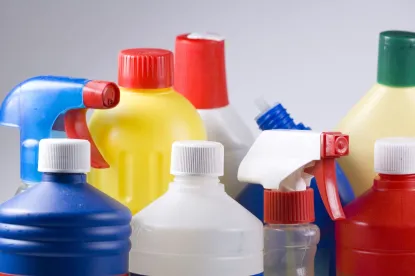Key Takeaways
The term “PFAS” has become a “four-letter word” that refers to a common group of perfluoroalkyl and polyfluoroalkyl chemical substances, which are the subject of increasing regulation. There are several key takeways from this PFAS Client Alert including:
How does the recent increase in the regulation of PFAS chemicals in consumer products impact your business?
What are the potential federal regulations of PFAS chemicals?
How best to identify and correct improper use of PFAS chemicals in consumer products?
Introduction
Colorado has become the most recent state to regulate the use of PFAS chemicals in consumer products. It is important that manufacturers and retailers become aware of these restrictions now to avoid future compliance issues since the state regulations of PFAS chemical use are not the same state to state. Further, the compliance issues imposed by state regulations will be compounded if the federal government fulfills its promise to regulate PFAS chemicals. Multiple federal agencies have indicated that such federal regulations may be forthcoming in the near future.
Brief Definition of PFAS
Per- and polyfluoroalyyl substances (PFASs, CnF2n+1–R) are a large group of man-made chemicals that includes perfluorooctaanoic acid (PFOA), perfluoroctane sulfonate (PFOS), and GenX chemicals.1 These chemicals are widely used, long-lasting chemicals that contain components that break down very slowly over time. PFAS chemicals have been used in industry and consumer products since the 1940s because of their useful properties. For instance, PFAS chemicals are used to make fluoropolymer coatings and products that resist heat, oil, stains, grease, and water. These can include clothing, furniture, adhesives, food packaging, and many other products.2 Because of their widespread use and persistence in the environment, many PFAS are found in the bloodstream of people and animals all over the world and are present at low levels in a variety of food products and in the environment.
Colorado Joins a Growing list of states to implement PFAS regulations for consumer products
Colorado recently adopted into law the Perfluoroalkyl and Polyfluoroalkyl Chemicals Consumer Protection Act (the “Colorado PFAS Act”)3, which regulates the use of PFAS chemicals in certain consumer products. The Colorado General Assembly concluded that such regulation is necessary upon the determination that “PFAS chemicals pose a significant threat to the environment of the state and the health of its residents.”4 Accordingly, by its terms, the Colorado PFAS Act was implemented into law in order “to create a regulatory scheme that phases out the sale or distribution of certain products and product categories in the state that contain intentionally added PFAS chemicals.”5 In furtherance of this goal, the Colorado PFAS Act will phase out the sell and distribution of certain consumer products that contain “intentionally added PFAS chemicals” from January 1, 2024, through January 1, 2027.6
These phase-out regulations within the Colorado PFAS Act are consistent with a national trend of states regulating the sale and distribution of consumer products containing PFAS chemicals. Notably, the Colorado PFAS Act now establishes Colorado as one of at least 8 states that regulate the sale and distribution of “food packaging” that contains intentionally added PFAS chemicals. Below is the list of states that currently prohibit or restrict PFAS chemicals in certain consumer products.
State |
Law |
Prohibition Date |
|
California |
Cal. Health & Safety Code § 109000(b) |
January 1, 2023 |
|
Colorado |
C.R.S.A. § 25-15-604(1) |
January 1, 2024 |
|
Connecticut |
C.G.S.A. § 22a-255i(e) |
December 31, 2023 |
|
Maine |
32 M.R.S.A. § 1733(3-B)(B) |
January 1, 2022 or 2 years after finding by the Department of Environmental Protection that a “safer alternative is available,” whichever is later. |
|
Minnesota |
M.S.A. § 325F.075 |
January 1, 2024 |
|
New York |
N.Y. E.C.L. § 37-0209 |
December 31, 2022 |
|
Vermont |
18 V.S.A. § 1672(a) |
July 1, 2023 |
|
Washington |
WA ST 70A.222.070(5) |
May 2024; implemented two years after Washington’s Department of Ecology submits a finding of safer alternatives to the Colorado Legislature. |
Beyond the differing timeline in the above chart, it is important to note these regulations are not synonymous since the term “food packaging” is defined differently by each regulating state.
Ignorance Is No Defense
The Colorado PFAS Act also does not allow ignorance of the contents of a commercial product as prohibiting the enforcement of its regulations. It is true that the Colorado PFAS Act prohibits the sale and distribution of certain products that contain “intentionally added PFAS chemicals.”7 However, the Colorado PFAS Act defines “intentionally added PFAS chemicals” as “PFAS chemicals that a manufacturer has intentionally added to a product and that have a functional or technical effect on the product.”8 Here, the “intent” element necessary to trigger the regulations of the Colorado PFAS Act is the intent to add any chemistry which includes any listed PFAS chemicals. The Colorado PFAS Act defines “product” to “include” any product components.”9 Thus, a “manufacturer” of consumer goods must understand all additive materials to its products through each stage of the supply chain.
Likely Federal regulation by the end of the year (2022)10
The U.S. Environmental Protection Agency (EPA) is expected to propose new regulations for groups of PFAS in drinking water in the Fall of 2022 before the Agency’s statutory deadline in March 2023. A final rule is anticipated in Fall 2023 after considering public comments on the proposal. In new health advisories issued in June 2022, EPA announced that it would drastically reduce the acceptable levels for two types of PFAS (perfluorooctane sulfonate (PFOS) and perfluorooctanoic acid (PFOA)) in drinking water from 70 parts per trillion down to just 0.004 parts per trillion for PFOA and 0.02 parts per trillion for PFOS.11 Generally, when EPA issues a health advisory it is considered to be a preliminary step in the process of setting maximum contaminant levels (MCL) in subsequent regulations. It is also important to note that some states, in the absence of a federal MCL, have already established their own enforceable regulations on drinking water standards for PFOA and PFOS. For instance, Vermont, Michigan, and New Jersey have all set limits ranging from 8 to 20 parts per trillion for both chemicals. However, the issuance of the health advisory by the EPA will require States to reevaluate their own regulations to conform with the new standards set by the Agency.
By Winter 2022, the EPA plans to leverage federally-issued water permits under the National Pollution Discharge Elimination System (NPDES) program to reduce PFAS discharges and will propose monitoring requirements at facilities where PFAS are expected or suspected to be present in wastewater and stormwater discharges, using its recently published analytical method 1633, which covers 40 unique PFAS. EPA will issue new guidance recommending that state-issued permits that do not already include monitoring requirements for PFAS use the method 1633 at facilities where PFAS is expected or suspected to be present in wastewater and stormwater discharges. In addition, the new guidance will recommend the full suite of permitting approaches that the EPA will use in federally-issued permits. The EPA expects to publish a multi-laboratory validation method to detect up to 40 specific PFAS compounds in eight environmental matrices with the Department of Defense online by Fall 2022.
Potential Changes Under Federal Environmental Laws
-
Proposed RCRA Changes12
In recent months, EPA has set the stage for greater regulation and firm federal standards on PFAS chemicals that could significantly impact cleanup requirements. In October of 2021, the EPA responded to a petition from Governor Michelle Lujan Grisham of New Mexico to tackle PFAS contamination under the Resource Conservation and Recovery Act (RCRA). EPA outlined plans to initiate a rulemaking process for two new actions under the hazardous waste law. The first rulemaking effort will initiate the process to propose adding four PFAS chemicals as RCRA Hazardous Constituents under Appendix VIII, by evaluating the existing data for these chemicals and establishing a record to support a proposed rule. The four PFAS chemicals EPA will evaluate are perfluorooctanoic acid (PFOA), perfluorooctane sulfonic acid (PFOS), perfluorobutane sulfonic acid (PFBS), and GenX. Adding these chemicals as RCRA hazardous Constituents would ensure they are subject to corrective action requirements and would be a necessary building block for future work to regulate PFAS as a listed hazardous waste. The second rulemaking effort will clarify in EPA regulations that the RCRA Corrective Action Program has the authority to require investigation and cleanup for wastes that meet the statutory definition of hazardous waste, as defined under RCRA section 1004(5). This modification would clarify that emerging contaminants such as PFAS can be cleaned up through the RCRA corrective action process.
-
Proposed CERCLA Changes13
In June 2021, EPA restarted the process to designate PFOA and PFOS as Comprehensive Environmental Response, Compensation, and Liability Act (CERCLA) hazardous substances. A proposed rule was expected in the Spring of 2022, no such rule has been proposed. According to the EPA’s “PFAS Strategic Roadmap,” a final rule is expected in the Summer of 2023 and the EPA is currently developing a Notice of Proposed Rulemaking to designate PFOA and PFOS as CERCLA hazardous substances. Such designations would require facilities across the country to report on PFOA and PFOS releases that meet or exceed the reportable quantity assigned to these substances. The hazardous substance designations would also enhance the ability of federal, tribal, state, and local authorities to obtain information regarding the location and extent of releases. EPA or other agencies could also seek cost recovery or contributions for costs incurred for the cleanup.
The designation of PFOA and PFOS as hazardous substances under CERCLA could substantially impact existing and new cleanup sites. Site owners and responsible parties who release PFOA or PFAS, and possibly other PFAS chemicals will be obligated to report releases, quantify the location and amounts released to stakeholders, and may be liable for partial or total cleanup. Regulatory changes may also delay cleanup and add significant analytical costs for companies who need to evaluate PFAS in various media prior to releases of any kind to waste streams. The designation of PFAS as hazardous substances has not yet been ratified at a federal level. However, several states (e.g., Washington DOE) have enacted Public Health Goals for surface and drinking waters and cleanup standards – several that incorporate federal hazardous substances lists, ensuring that the impending PFAS regulations will extend beyond federally designated cleanup sites.
Potential Changes Under TSCA Regulations14
The Toxics Release Inventory (TRI) under the Toxic Substance Control Act (TSCA) helps the EPA compile data and information on releases of certain chemicals and supports decisions by companies, regulatory agencies, and the public. The EPA intends to implement a rulemaking in 2022 to categorize the PFAS on the TRI list as “Chemicals of Special Concern” and remove the de minimis eligibility from supplier notification requirements for all “Chemicals of Special Concern.” It is expected for the EPA to continue to update and add to the list of PFAS subject to the TRI. EPA’s proposed rule would require all manufacturers (including importers) of PFAS in any year since 2011 to report information related to chemical identity, categories of use, volumes manufactured and processed, byproducts, environmental and health effects, worker exposure, and disposal. There is still opportunity for public comments as the rule is not set to finalize until January of 2023.
Industries Should Take Protective Measures
Both the implementation of the Colorado PFAS Act and the recent actions of the EPA establish that the time for manufacturers and retailers to act is now. Specifically, manufacturers and retailers should implement quality control practices directed towards identifying—and where necessary altering—the chemical contents of their consumer products.
To implement such quality control practices, manufacturers and retailers should review their wastewater handling processes and insurance policies for periods of past PFAS chemicals use. These previous processes and insurance policies likely identify the specific components of PFAS chemicals that were deemed to violate state wastewater regulations, as well as the internal changes implemented to eliminate the use of such chemicals. Similar practices can likely be implemented in the sale and distribution of consumer products that include PFAS chemicals. Manufacturers and retailers should consider implementing practices now to limit exposure and costs once regulation of PFAS consumer products becomes both effective and more prevalent.
Footnotes
1 Zhanyun Wang et al., A Never-Ending Story of Per- and Polyfluoroalkyl Substances (PFASs)?, 51 ENV’L SCI. TECH. 2508.
2 CTR. FOR DISEASE CONTROL AND PREVENTION, "PFAS Factsheet" (last visited June 24, 2022).
3 C.R.S.A. § 25-15-601 et seq.
4 C.R.S.A. § 25-15-602(1)(a).
5 C.R.S.A. § 25-15-602(2).
6 C.R.S.A. §§ 25-15-604(1), (3)-(4).
7 C.R.S.A. § 25-15-604(1), (3), and (5).
8 C.R.S.A. § 25-15-603(12)(a).
9 C.R.S.A. § 25-15-603(20)(b).
10 All information gathered in this section comes from ENV’L PROT. AGENCY PFAS Strategic Roadmap: EPA’s Commitments to Action 2021-2024 (last visited June 24, 2022).
11 Juan Carlos Rodriguez, 3 Takeaways from EPA’s Guidance on PFAS in Drinking Water, Law360 (June 22, 2022, 8:48 PM EDT).
12 EPA News Release, EPA Announces New Drinking Water Health Advisories for PFAS Chemicals, $1 Billion in Bipartisan Infrastructure Law Funding to Strengthen Health Protections (June 15, 2022).
13 Information on RCRA changes comes from EPA Press Release, responding to New Mexico Governor’s petition to tackle PFAS contamination under RCRA (Oct. 26, 2021).
14 All information gathered in this section comes from EPA, PFAS Strategic Roadmap: EPA’s Commitments to Action 2021-2024 (Oct. 2021).






 />i
/>i
